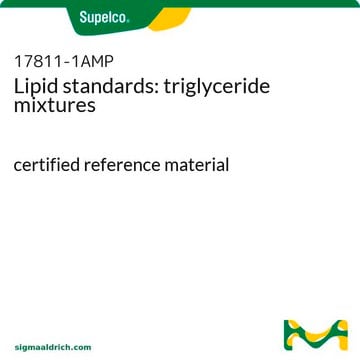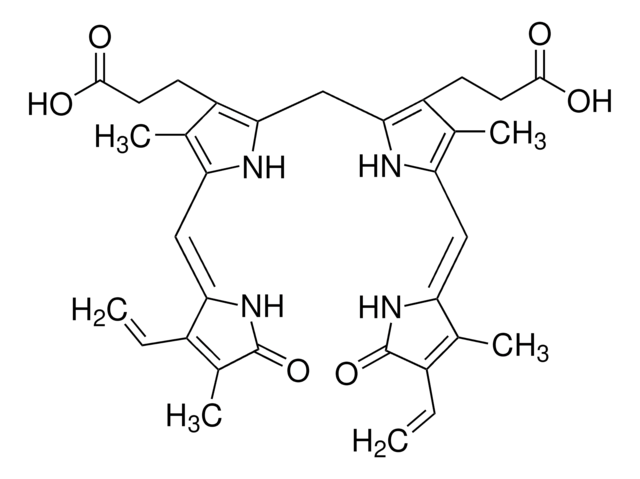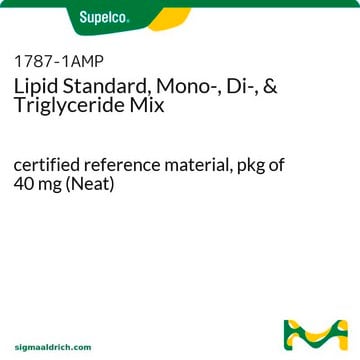Products may be shipped at a different temperature than the recommended long-term storage temperature. If the product quality is sensitive to short-term exposure to conditions other than the recommended long-term storage, it will be shipped on wet or dry-ice. If the product quality is NOT affected by short-term exposure to conditions other than the recommended long-term storage, it will be shipped at ambient temperature. As shipping routes are configured for minimum transit times, shipping at ambient temperature helps control shipping costs for our customers. For more information, please refer to the Storage and Transport Conditions document: https://www.sigmaaldrich.com/deepweb/assets/sigmaaldrich/marketing/global/documents/316/622/storage-transport-conditions-mk.pdf
17810
Triglyceride Mix
C2 - C10, ampule of 100 mg (Neat)
Synonym(s):
Lipid standards: triglyceride mixtures
Select a Size
About This Item
Recommended Products
grade
analytical standard
Quality Level
form
liquid
CofA
current certificate can be downloaded
packaging
ampule of 100 mg (Neat)
format
multi-component solution
shipped in
dry ice
storage temp.
-10 to -25°C
Looking for similar products? Visit Product Comparison Guide
Related Categories
Application
Packaging
Triacetin (C2:0)
Tributyrin (C4:0)
Tricaproin (C6:0)
Tricaprylin (C8:0)
Tricaprin (C10:0)
Related product
Storage Class
10 - Combustible liquids
wgk_germany
WGK 3
flash_point_f
300.0 °F
flash_point_c
148.9 °C
Choose from one of the most recent versions:
Certificates of Analysis (COA)
Don't see the Right Version?
If you require a particular version, you can look up a specific certificate by the Lot or Batch number.
Already Own This Product?
Find documentation for the products that you have recently purchased in the Document Library.
Customers Also Viewed
-
How is shipping temperature determined? And how is it related to the product storage temperature?
1 answer-
Helpful?
-
-
How can I determine the shelf life / expiration / retest date of this product?
1 answer-
If this product has an expiration or retest date, it will be shown on the Certificate of Analysis (COA, CofA). If there is no retest or expiration date listed on the product's COA, we do not have suitable stability data to determine a shelf life. For these products, the only date on the COA will be the release date; a retest, expiration, or use-by-date will not be displayed.
For all products, we recommend handling per defined conditions as printed in our product literature and website product descriptions. We recommend that products should be routinely inspected by customers to ensure they perform as expected.
For products without retest or expiration dates, our standard warranty of 1 year from the date of shipment is applicable.
For more information, please refer to the Product Dating Information document: https://www.sigmaaldrich.com/deepweb/assets/sigmaaldrich/marketing/global/documents/449/386/product-dating-information-mk.pdfHelpful?
-
-
Is standard 17810 actually in the amount of 100 mg? Are standards weighed to the exact amount as indicated?
1 answer-
The standard 17810 is not actually in the amount of 100 mg. Both neat (pure) and solution standards are typically weighed or dispensed with approximately 10-15% extra product to allow for accurate measurement of the total amount indicated. Therefore, while it is indicated to have 100mg, there is an extra amount typically added during the weighing and packaging process
Helpful?
-
-
해당 제품을 50 mg/mL로 희석하여 사용하고자 합니다. 알맞은 용매가 있을까요?
1 answer-
This product is not tested for solubility. Lipids are not directly soluble in aqeuous solutions. Typically, strong non-polar solvents are used to dissolve these compounds. Hexane has been used in analytical testing of the individual triglyderides. In most liquid chromatography techniques the solvents utilized are acetone and/or acetonitrile. In gas chromatography the mixture is derivatized to methyl esters using hexane, ether, or toluene. Pyridine is also a suitable solvent prior to derivatization with MSTFA. During manufacturing, chloroform is commonly used.
Other suggested intermediate solvents include acetone, ethanol, and dimethylsulfoxide. Please see the link below to review additional information on lipids:
http://www.cyberlipid.org/Helpful?
-
-
こちらの製品(17810)のモル濃度と液量が知りたいです
1 answer-
This product is a neat or pure liquid that is sold by weight. Each 100 mg ampule is comprised of approximately 20% of each component:
Tributyrin, CAS 60-01-5, density 1.032 g/mL, MW 302.36
Tricaproin, CAS 621-70-5, density 0.98 g/mL, MW 386.52
Triacetin, CAS 102-76-1, density 1.16 g/mL, MW 218.20
Tricaprylin, CAS 538-23-8, density 0.956 g/mL, MW 470.68
Tricaprin CAS 621-71-6, powder, MW 554.84The exact volume is not reported, however, based on the densities of the components, a 100 mg package would have a volume of approximately 100 ul.
Helpful?
-
Active Filters
Our team of scientists has experience in all areas of research including Life Science, Material Science, Chemical Synthesis, Chromatography, Analytical and many others.
Contact Technical Service







